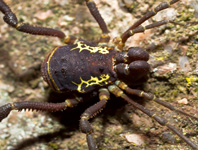Abstract
A preliminary assessment of barcode data for the genus Rhamma suggests the presence of several cryptic species in Colombia. Based on morphology and barcodes, we were able to diagnose one of these lineages as a new species that is described herein as Rhamma dawkinsi, sp. nov. Adult specimens and the genitalia of both sexes are illustrated and compared with R. adunca (Draudt, 1919) and R. comstocki (Johnson, 1992), the most closely related species based on phenotypic appearance.
References
deWaard, J.R., Ivanova, N.V., Hajibabaei, M. & Hebert, P.D.N. (2008) Assembling DNA barcodes: analytical protocols,. In: Martin, C. (Ed.), Methods in molecular biology: environmental genetics. Humana Press Inc, Totowa, pp. 275–293.
https://doi.org/10.1007/978-1-59745-548-0_15Eliot, J.N. (1973) The higher classification of the Lycaenidae (Lepidoptera): a tentative arrangement. Bulletin of the British Museum of Natural History (Entomology), 28 (6), 373–506.
https://doi.org/10.5962/bhl.part.11171Hebert, P.D.N., Penton, E.H., Burns, J.M., Janzen, D.H. & Hallwachs, W. (2004) Ten species in one: DNA barcoding reveals cryptic species in the neotropical skipper butterfly Astraptes fulgerator. Proceedings of the National Academy of Sciences of USA, 101 (41), 14812–14817.
https://doi.org/10.1073/pnas.0406166101Huelsenbeck, J.P. & Hillis, D.M. (1993) Success of phylogenetic methods in the four-taxon case. Systematic Biology, 42, 247–264.
https://doi.org/10.1093/sysbio/42.3.247
Ivanova, N.V., deWaard, J.R. & Hebert, P.D.N. (2006) An inexpensive, automation-friendly protocol for recovering high-quality DNA. Molecular Ecology Notes, 6, 998–1002.
https://doi.org/10.1111/j.1471-8286.2006.01428.x
Johnson, K. (1992) Genera and species of the Neotropical “elfin”-like hairstreak butterflies (Lepidoptera, Lycaenidae, Theclinae). Reports of the Museum of Natural History, University of Wisconsin, 22, 1–279.
Kumar, S. & Gadagkar, S.R. (2000) Efficiency of the neighbor-joining method in reconstructing deep and shallow evolutionary relationships in large phylogenies. Journal of Molecular Evolution, 51, 544–553.
https://doi.org/10.1007/s002390010118Mihaescu, R., Levy, D. & Pachter, L. (2009) Why neighbor-joining works. Algorithmica, 54, 1–24.
https://doi.org/10.1007/s00453-007-9116-4
Mutanen, M., Kivelä, S.M., Vos, R.A., Doorenweerd, C., Ratnasingham, Hausmann, A., Huemer, P., Dincă, V., van Nieukerken, E., Lopez-Vaamonde, C., Vila, R., Aarvik, L., Decaëns, T., Efetov, K., Hebert, P., Johnsen, A., Karsholt, O., Pentinsaari, M., Rougerie, R., Segerer, A., Tarmann, G., Zahiri, R. & Godfray, H.C. (2016) Species-Level Para- and Polyphyly in DNA Barcode Gene Trees: Strong Operational Bias in European Lepidoptera. Systematic Biology, 65 (6), 1024–1040.
https://doi.org/10.1093/sysbio/syw044
Prieto, C. & Vargas, M.A. (2016) Elfin butterflies of the genus Rhamma Johnson (Lepidoptera: Lycaenidae: Theclinae): A review of the Colombian species. Zootaxa, 4093 (3), 323–342.
https://doi.org/10.11646/zootaxa.4093.3.2
Robbins, R.K. (1991) Evolution, comparative morphology, and identification of the Eumaeini butterfly genus Rekoa Kaye (Lycaenidae. Theclinae), Smithsonian Contributions to Zoology, 498, 1–64.
Robbins, R.K. (2004a) Introduction to the Checklist of Eumaeini. In: Lamas, G. (Ed.), Checklist of Neotropical Lepidoptera. Part 4A. Hesperoidea- Papilionoidea. In: Heppner, J. (Series Ed.), Atlas of Neotropical Lepidoptera. Scientific publishers, Gansville, pp. xxiv–xxx.
Robbins, R.K. (2004b) Checklist of Eumaeini. 98. Lycaenidae Theclinae, Eumaeini. In: Lamas, G. (Ed.), Checklist of Neotropical Lepidoptera. Part 4A. Papilionoidea. In: Heppner, J. (Series Ed.), Atlas of Neotropical Lepidoptera. Scientific publishers, Gansville, pp. 118–137.
Winter, W.D. (2000) Basic Techniques for Observing and Studying Moths & Butterflies. The Lepidopterists’ Society Memoir, 5, i–xviii, 1–444.

